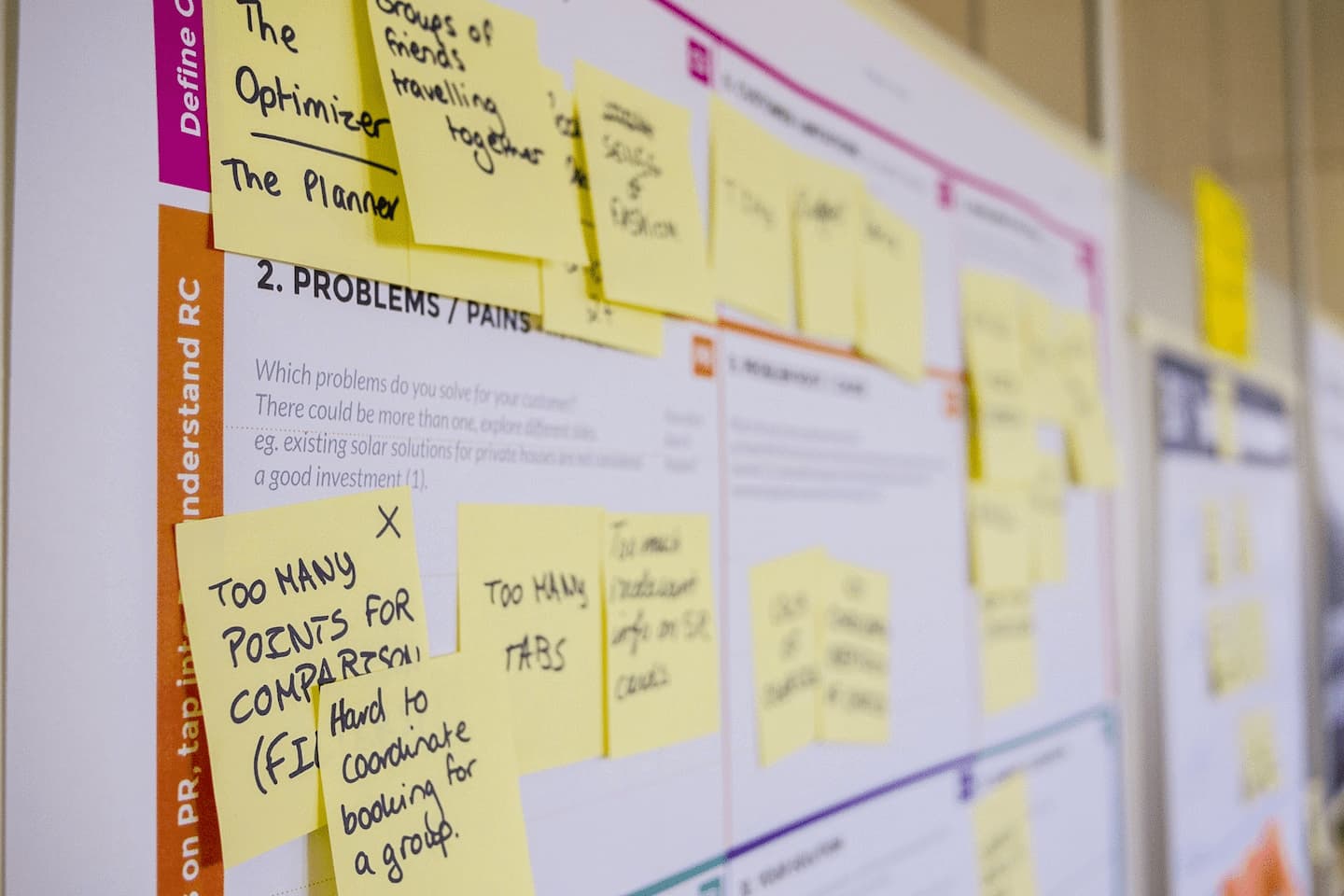Navigating the intricate landscape of project management requires more than just a plan; it demands a well-defined project management methodology. They provide structured frameworks for organizations to execute tasks, allocate resources, and achieve their objectives. From traditional approaches to agile methodologies, each method offers a unique set of principles and practices.
Without it, it’s impossible to estimate a project budget, gather a team, manage resources, or allocate time efficiently. You’ll need a detailed and clear plan.
In this article, you’ll learn what project management methodologies are, and their advantages and disadvantages. You’ll also get useful tips on how to put your project management methodology into action and get results. We’ll also discuss how the integration of the best time tracking software can elevate your project management process, providing essential insights to optimize workflow and ensure project success.
Project Management Methodologies: The Basics
Let’s start at the beginning. Project management methodologies (PMM) are a set of rules, project management principles, and techniques that defines:
- How your team should perform on a project
- What tools will your team use
- How you can check and evaluate the outcome
Project management methodologies are widely used in the IT-sphere, but not only. You can use them in any field that requires an in-depth approach to a project or activity. And break down their structure by factors, including time, size of the team, the project budget, and its quality metrics.
Each methodology has its own advantages and disadvantages. Although the list of PM methodologies seems pretty long, you don’t have to know all of them or follow them to the letter.
But, you need to spend some time to think your future project’s rules and tools over. You can even mix different project management methodologies to create your own way to fit your project better.
Types of Project Management Methodologies
Let’s have a look at the most popular and most used project management methodologies and examples.
IT Project Management Methodologies
IT projects are fast-moving, flexible, and dynamic. That’s why they require a specific set of project management methodologies to match. These project management methodologies aid IT product development and its delivery.
You’ve may have noticed, IT projects are often characterized by their complexity, involving business processes, organizational structure, and risks. Therefore it’s essential to set clear aims, purposes, and assessment strategies.
When starting a new project, IT project managers can mix several general or IT management methodologies. This approach makes such projects flexible, enables the teams to release their products fast, and monitors user feedback to the product.
Agile Project Management: Key Principles for Flexibility
The Agile model is often contrasted to the Waterfall model which will be discussed in detail below. Unlike Waterfall, where the steps resemble water flowing only one way down the mountain, Agile uses iteration. This is used for error correction and flexible analysis of customer demands and software development methods.
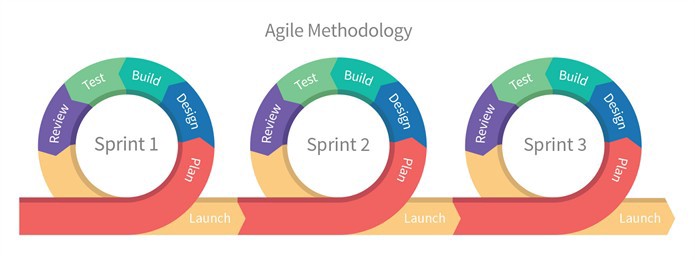
This methodology was established in 2001 in Utah when 17 software developers gathered to discuss their approaches to software development aside from Waterfall. At this conference, the developers presented the Agile Manifesto. It contains the main principles of Agile. Read these and decide whether Agile could work for you.
Main agile principles
- Individuals and interactions over processes and tools: People have different working styles and often it’s much easier to solve some issues quickly in collaboration rather than following prescribed procedures.
- Working software over comprehensive documentation: For Agile, it’s much more essential that your product works rather than well-developed documentation.
- Customer collaboration over contract negotiation: Customers should take an active part in product development and put forward proposals on its improvement.
- Responding to change over following a plan: This means that the changed requirements for the product are much far more important than the product specifications negotiated at the start. The customer knows better what kind of product they need as an outcome, so they decide on its qualities and features.
Elements of agile project management methodology
- Change is welcomed: Meaning that the customers, the team, and the project managers are ready for alterations to the original project that will be discussed and implemented to the product along with the project’s deployment.
- Incremental development: The product improves after each iteration and is developed gradually. An iteration means that each product component is discussed, created, checked, and implemented completing the project as successfully as possible.
- Frequent releases and feedback: To meet customer expectations, the software being designed undergoes short development cycles in increments. After each iteration, the team presents its product result for customer feedback.
- Client participation in product design: The client delivers feedback and suggests product modifications, as part of the project team.
Scrum vs Kanban: Choosing the Right Agile Approach
Scrum and Kanban are two of the most popular Agile project management methodologies. Let’s break them down.
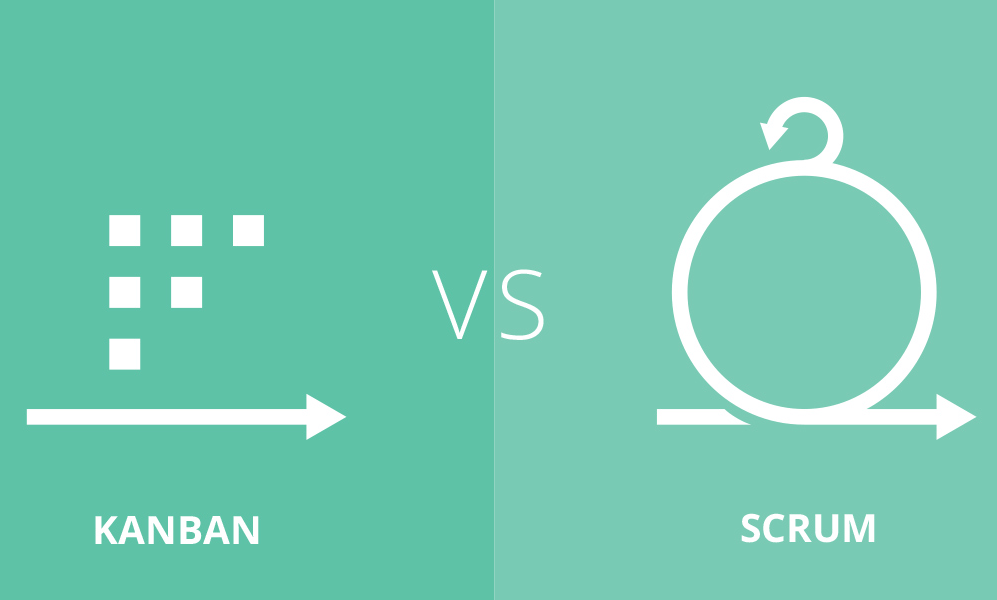
Scrum teams commit to shipping working software in set intervals called sprints. Their goal is to create learning loops to quickly gather and integrate customer feedback. Scrum teams adopt specific roles, create special artifacts, and hold regular ceremonies to keep things moving forward.
Kanban is all about visualizing your work, limiting work in progress, and maximizing efficiency (or flow). Kanban teams focus on reducing the time it takes to make a project (or user story) from start to finish. They do this by using a kanban board and continuously improving their flow of work.
Kanban is ideal for businesses that are ready to provide quick results. Meanwhile, they spend their resources on frequent product fixing, improvement, and close cooperation with their customers.
Advantages and disadvantages
- Quick implementation in the next iteration after discussions with a client
- Resource minimization due to frequent negotiations of further steps
- Product and teams are flexible and adaptable
- Efforts are more focused on product development
- Quick defect detection and early product testing
- More satisfactory product as an outcome due to customer involvement in product development
- Quick and frequent feedback
- Intense collaboration and communication inside the team.
- Not everyone is ready to adopt Agile. Some companies will have to run into a whole company structure renovation to implement Agile. For example, they will need to change workflow, teach employees, and negotiate with current clients.
- To get results, you should know how to implement it That means that you and your employees will need extra training.
Agile tools
Got a good grasp of what Scrum and Kanban are about? Great. Once you’re happy with the Scrum framework, it’s time to find a Scrum tool that serves you well. The same goes for Kanban. Jira software supports both Scrum and Kanban workflows, and it can be integrated flawlessly with time tracking apps.
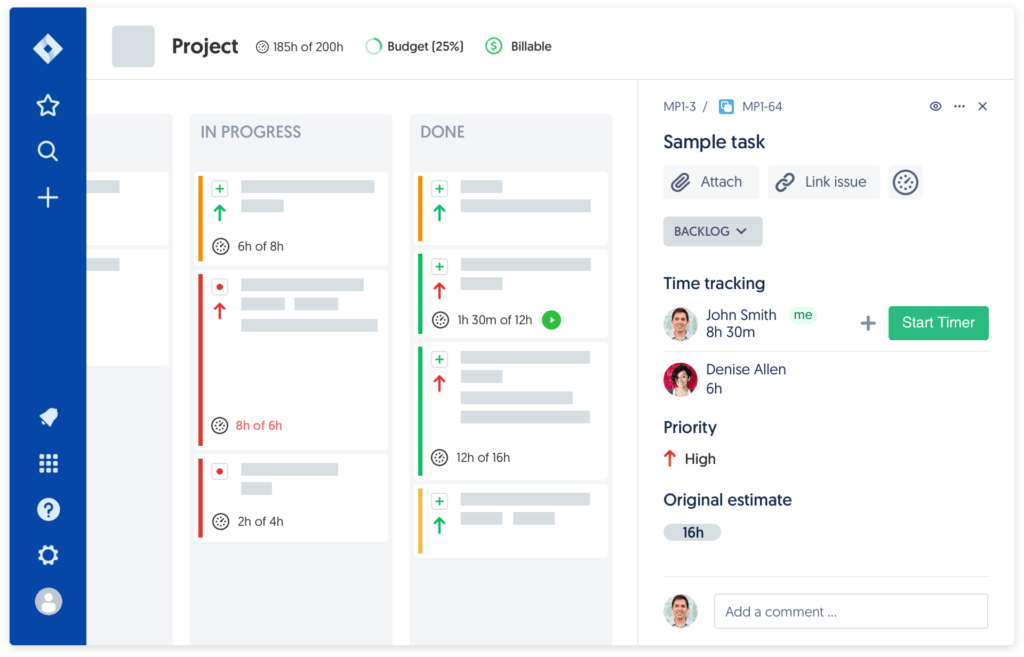
Waterfall Methodology: Structured Project Planning
The Waterfall method is one of the first methodologies created for managing software development. Essentially, if you take the Traditional Project Management approach and apply it to the IT-sphere you’ll get the Waterfall model.
It was first presented by Herbert D. Benington at the Symposium on Advanced Programming Methods for Digital Computers in 1956.
It’s called Waterfall as its steps resemble water flowing down the mountain, like a real-life waterfall.
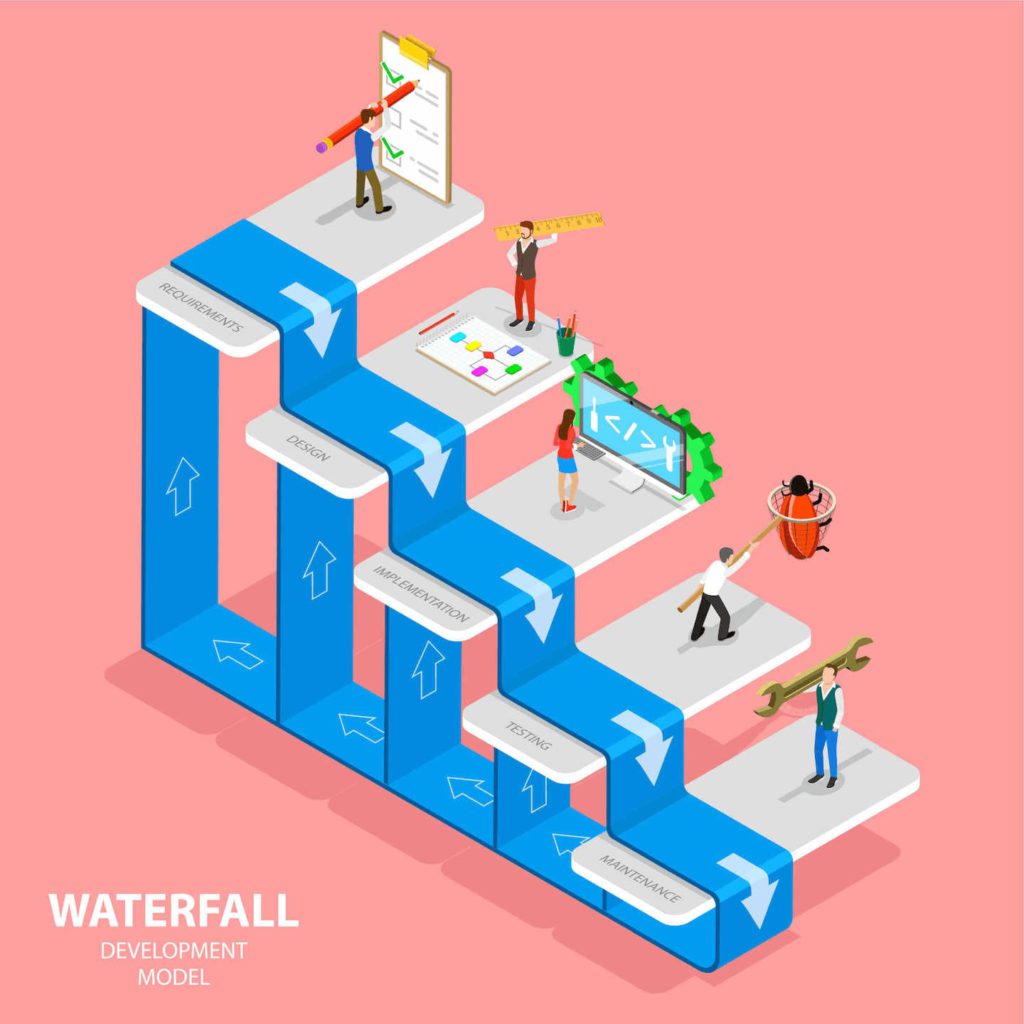
To apply the Waterfall methodology, you should take these steps
1) Setting the requirements
- Identifying the business needs
2) Creation of documentation
- Creating business requirements and specifications
- Developing software development architecture
- Choosing software development technology
3) Development of the product
- Creating the product
4) Probing and testing of the product
- Software developers conduct unit tests
- QA engineers test the software product
5) Release and maintenance of the product
- Releasing your product
- Providing necessary support to the users
For effective project management, using digital project management tools and useful integrations is the way to go. They will help you keep all the tasks in one place and estimate your input in the project.
Advantages and disadvantages
- Stable and well-developed and documentation from the start until the end of the project.
- More accessible training of newcomers that can study a project from the elaborated documents.
- Better time planning for the team members as the responsibilities are clear and the work is scheduled.
- Clients have a complete understanding of the product they’ll receive at the Release stage. Transparent budget spending, trackable working time of each employee.
- The project is easy to estimate and measure progress.
- High-quality product due to detailed documentation and allocated time for testing.
- Once you’ve finished a stage in the Waterfall model, it’s almost impossible to go back and fix the flaws. As a result, the planning stage bears the responsibility for the whole project.
- As there is no rollback, all the errors made, transfer to the next stage with little chance to correct them, resulting in a drop in product quality.
- If you’re late at one stage of your project, the project deadline moves to further dates.
- QA testing starts too late when the code is ready and mistakes correction gives little result.
- If a project is late, some businesses try to cut time at the testing stage, causing bugs and system faults in the product.
- Too slow in its implementation. By the time of release, the client’s requirements may change due to the business needs and the final product may become irrelevant.
- The Waterfall model doesn’t allow for any unforeseen issues, meaning that your team can run into them during the project.
Who is it suitable for
The Waterfall methodology is best suited to small outsourcing projects or straightforward software engineering projects, where little change is expected or budget constraints apply. The requirements for the product change less often than in outsourcing companies, and the risks are lower.
Apart from project management, small companies can face such difficulties as to how to estimate employees’ working time, calculate overtime pay or write invoices, which all need to fit into the project timeline.
General project management methodologies
General project management methodologies suit a broad range of projects. You can implement them for small- and large-scale activities. And even those involving different budgets and a number of members in the team.
The main difference between these and IT project management methodologies is that they can be used in various fields, such as construction, state administration, or the financial sector, etc.
Let’s take a look at some of them.
Critical Path Method (CPM)
The Critical Path Method was developed for large-scale, multi-action projects by El DuPont de Nemours Company in the late 50s.
It has a mathematical algorithm at its core that helps identify a critical path in your project.
Critical Path’s main feature is the way it calculates the shortest project duration possible by lining up the longest sequence of dependent tasks necessary to complete the project.
CPM has been widely used since 1958 when it was first successfully used to construct a chemical plant. It makes time and task planning a priority, helping you to stay on track with deadlines while performing complicated tasks.
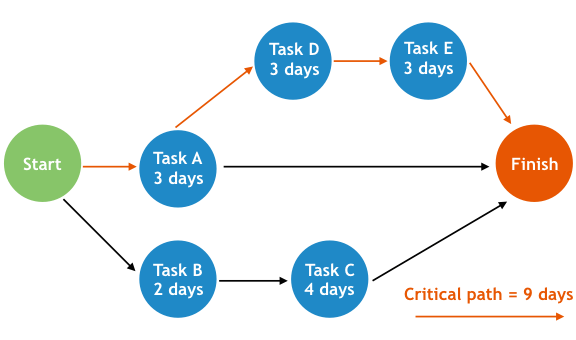
To implement the CPM method, you need to follow these steps
1) Gather and systemize your tasks
- Making a list of your tasks
- Assigning each task with a name or a shortcode
- Defining each task’s duration and deadline
2) Order task flow
- Putting your tasks in a logical line-up
- Identifying dependencies of your tasks
3) Create a network diagram
- Making your task line-up visual by using a network diagram
- Connecting your tasks in the chart
4) Allocate the time
- Determining the time you need to complete each task in the project
5) Identify the critical path
- Finding the longest sequence of project tasks in the diagram.
Explanation video
At the start, you’ll have to rely on your previous experience to complete tasks and add an approximate time for each task. After that, make it in habit to track your time for each task. That way, you’ll be able to estimate your time more precisely in the future.
Advantages and disadvantages
- CPM is best suited for large projects with lots of people and resources. It not only helps to organize but also to track project completion at each step of its development.
- With CPM, you can easily track the bottlenecks of the project and refocus your resources to complete the project tasks on time.
- If you run into a lengthy delay while completing any task of your project, you’ll have to move the entire project deadline to a later date.
Who is it suitable for
Medium and big businesses that run ambitious projects.
PERT Network Chart Methodology
The Program Evaluation Review Technique (PERT) is similar to the CPM method. It also was developed at approximately the same time. This methodology was designed for the US Navy in 1958 and implemented in a submarine missile program.
For the Critical Path Network, you need to use a deterministic approach to estimation. I.e. in the CPM, you can’t account for completion time variance. In PERT, you create three timelines for each task to estimate your risks better.
The PERT Network acknowledges that there will be a time variance due to uncertainty and therefore uses a probabilistic approach to estimating for each activity.
To estimate for an activity, use this formula:
Expected time = ( Optimistic + 4 x Most likely + Pessimistic ) / 6
Together, the PERT and Critical Path methods had the biggest impact on the field of project management since the Gantt chart.
To successfully adopt the PERT technique, you should follow these steps
1) Systemize your tasks
- Writing down all of the tasks you need to do
- Figuring out the steps you should take to fulfill each task
2) Order your tasks
- Analyzing your tasks if you’re missing out on any steps
- Prioritizing your tasks by deadlines and length
3) Build a diagram
- Linking your tasks visually in a diagram by showing the transition between the phases
- Some tasks can be done in parallel to proceed to the next one
4) Allocate the time for each task
- Estimating the three possible scenarios for each task:
Optimistic time – the shortest time needed to do the task
Probable time – you’re highly likely to do the task at this time
Pessimistic time – the longest time needed to fulfill your task
- Making calculations on the expected time (ET), using the formula
5) Calculate your critical path
- Identifying the longest path in your diagram
- Calculating the time of all tasks in the longest path (SUM them up)
Explanation video
To align your tasks and estimate their time more precisely, you can use simple techniques, for example, the time-blocking technique.
Advantages and disadvantages
- With PERT, it’s easy to estimate and analyze the time and resources needed for a project.
- You can manage and track your team and duty holders, budget, and other resources at any stage of the project development.
- With this method, you can perform a “What-if” analysis, highlighting the probabilities and minimizing potential losses.
- PERT requires good estimation and analysis skills. Otherwise, your calculations may be subjective and do not reflect the real costs and time of the project.
- It focuses on time and is less flexible with the budget and technical aspects of the project.
- This method requires intense preparation and in-depth analysis of documentation and expert opinions before scheduling tasks.
Who is it suitable for
Medium and large companies with a sustainable base of experts and resources that run large and complex projects.
PRINCE2 Project Management Methodology
PRojects IN Controlled Environments (PRINCE2) is one of the most popular government project management methodologies. It was developed by the UK and has been proven in the most unpredictable of environments. That’s why such countries as the USA, Germany, Spain, South Africa, and others extensively use this style in public administration and for running profitable businesses.
PRINCE2 helps organize all the project stages and activities efficiently. It helps arrange and analyze in detail each project step and address the most common issues businesses encounter when establishing complex objectives.
Prince2 value the expectations of all parties involved in the project:
- The Customer expects results and benefits from the project.
- The Contractor predicts the methodologies on how to accomplish the project and possible challenges.
- Both customer and contractor should predict the future end-users’ opinions about the product.
Based on the participation of the three parties, there are 7 basic principles to follow in project performance:
- Feasibility. Is there is a reason to continue the project (for example, you have a customer and substantial benefits)?
- Learning from mistakes. Make a list of unfortunate decisions to analyze them and avoid in future projects.
- Clear role distribution. Each project member should know what to do and what they are responsible for. As a project manager, you can delegate tasks. All the work should be performed and presented by the responsible members.
- In stages management. Divide the project into distinct stages that are easy to monitor and evaluate.
- Product focus. Evaluate the product’s quality at each stage of project development.
- Flexibility. If a process is too long to perform, but not critical, you need to simplify it. For example, if it takes a lot of time to create a report on the results. Is it possible to report orally or send a quick email?
Stages of PRINCE2
1) Create a Project team
- Your team should include: Customer, Executive Director, and User Orientation Manager
- Establishing the project brief and project approach
- After defining internal document to proceed to the next stage
2) Initiate the project
- Detailing further project plans, control methods, and possible risks.
- As you have the idea of all the procedures and workflow on the project, move to the next stage.
3) Direct the project
- Exploring project direction and establishing the end date of the project.
4) Control the project stages
- The project manager analyzes the ongoing work
- PM introduces changes as necessary, handles emerging challenges, and reports on pressing issues to the Project team.
5) Manage your team
- The project manager delegates tasks
- PM monitors that the work is done according to the schedule
6) Manage the project stages
- If the project has encountered any serious challenges, it should be re-evaluated and updated by the team
- Your team should analyze the experience and the flaws that appeared in the project
7) Close the project
- Prepare the outcome report
- Evaluating the product quality by the end-users
- Analyzing end users’ opinions on the product.
Explanation video
To conveniently monitor each participant’s work in the project, you can use simple project management tools. These help you keep track of the project and its participants.
Advantages and disadvantages
- Robust project management methodology at its core. Clear project and team management. Each project member knows his duties and responsibilities.
- The project manager takes the role of an advisor rather than a guidance counselor and interferes in the process only when the workflow starts getting out of control.
- The Project team represents the interests of business, users, and contractors, providing a balanced decision.
- PRINCE2 was created for large-scale projects and ensures successful project accomplishment that has been proved by many businesses and countries.
- PRINCE2 applies to a vast range of projects starting from construction, ending in the IT-sphere.
- Not applicable to small flexible projects with unstable requirements. As the team won’t cope with the number of reports and mistakes monitoring.
- Novices in project management may fail to establish all the PRINCE2 stages and processes correctly and on time. This methodology requires extra training. Some project managers notice that PRINCE2 doesn’t include conflict management. This means that they need to search for additional practices on team building to include in the project management.
Who is it suitable for
Large companies or governmental projects with a lot of processes and people involved in a project.
Traditional project management approach
Traditional project management was first described in the 1950s. However, intuitively has been used for centuries. It’s a basic format that other methodologies are built upon.
The main steps of traditional project management include:
1) Initiation
- Setting project goals and objectives
- Estimating possible risks
2) Planning
- Identifying activities and their duration
- Mobilizing resources
- Documenting development
3) Execution
- Building a project team
- Organizing and exchanging information
- Project performing
- Project quality estimating
- Work scheduling
4) Monitoring
- Controlling the project scope, project budget, and project quality
- Reporting on progress
- Project-plan revision
Strictly speaking, it’s not a methodology, but a collection of techniques, like WBS (work breakdown structure), dividing a project into phases, Gantt charts, etc.
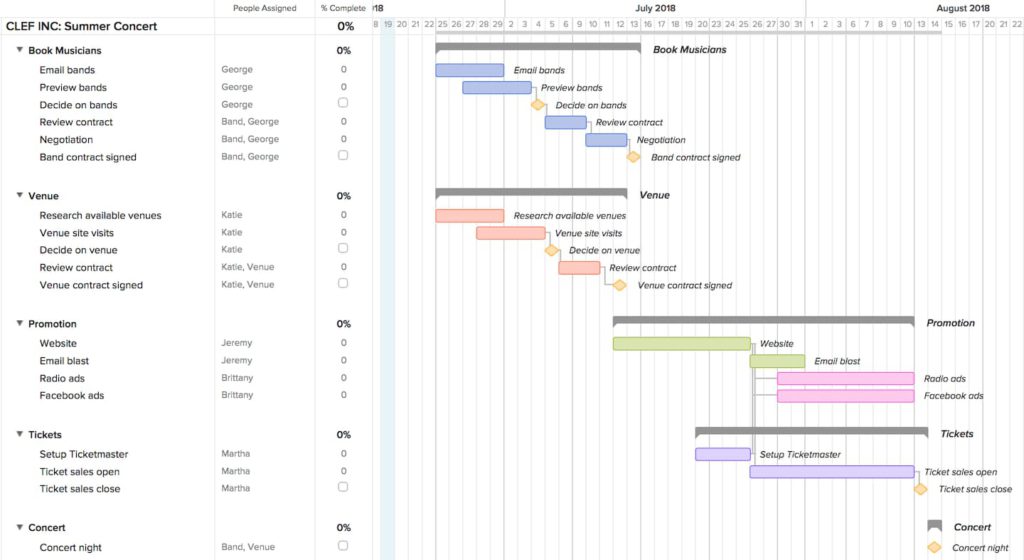
The Gantt chart visualizes the project’s schedule and shows its duration. It can include current goals and team members’ work.
Advantages and disadvantages
- The traditional project management methodology can be used for a wide range of projects of different sizes, budgets, and include various numbers of team members.
- Traditional project management requires you to complete each step in order. But in complex projects with a broad range of tasks, it’s not always possible or sensible to do. As they will require more frequent control, less-developed documentation, and team formation, even before the planning session.
Who is it suitable for
Perfect for freelancers and big companies alike. But, a word of warning. This one is not for complicated projects. So keep it simple.
How to Choose Methodology: Wrap Up
Project management methodologies are essential for project planning. You should use them from the get-go when developing your project. Don’t and it may fail before you even hit start.
Success means choosing a methodology that suits your project 100%. But remember, it is ok to mix several methods together or implement their best practices in your project without subscribing to just one.
Each has its own advantages and disadvantages. Take them into account when deciding the best methodology for your project.
And one final thing! When estimating the sources for your project, always remember that time is the most valuable asset you have. Use time-tracking apps to manage your project time and the working time of your team, and you’ll find project management becomes 2nd nature.
Time Tracking in Project Management With Everhour
If you are a development or consulting firm, you know your clients always have two things in mind before you sign any contract – how much it will cost and how long it will take.
The challenge for you and your team is to stay within the agreed estimates. That means keeping everything transparent during the full circle of the development process.
At Everhour, we help you track time and get results, no matter which project management methodology you choose. You’ll be able to:
- Track your working hours vs project hours
- Monitor employees performance on your projects
- Estimate costs for every project
- Plan resources for every project
- Create project reports
- Calculate overtime pay for your employees
- Count billable and non-billable working hours
- Develop proper invoices for your clients
- Integrate time tracking into your daily apps
If you are managing a team of 5 or more and looking to boost efficiency, Everhour is the perfect time tracking software for engineers, developers, and other professionals to keep your team on track. With seamless time tracking, you can easily estimate task durations, set clear budgets, and generate detailed reports inside Asana, Trello, Jira, or any other pm tool.
